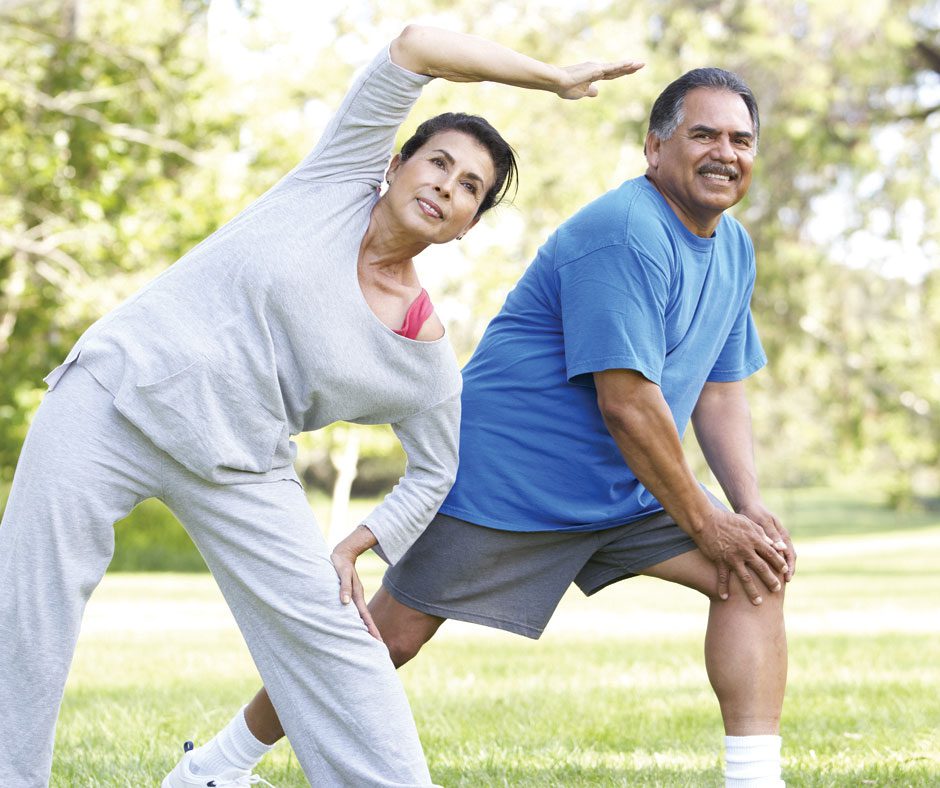Add years to your life and life to your years.
There are lots of reasons why we tend to become less active as we age. Health problems, achy joints, excess weight and fear of falling are just some of the excuses we give ourselves for not getting up and moving more. But as you grow older, an active lifestyle is more important than ever to your health.
Being physically active can improve the quality of your life. It can boost your mood, help maintain your independence, and reduce the risk of age-related diseases. It may even improve your sex life. Recent studies suggest that as little as 15 minutes of physical activity a day can boost your lifespan by three years.
If that’s not enough to get you off the couch, here are more ways exercise and physical activity can enhance your life:
- Lose weight
- Lower your blood pressure
- Strengthen your bones
- Lower your risk of Alzheimer’s disease, diabetes, heart disease and osteoporosis
- Lower your risk of falling
- Reduce arthritis pain
- Sleep better at night
- Manage stress and anxiety
- Improve mood and relieve depression
- Improve brain function
- Improve mental health
Which exercises are best for seniors?
Experts recommend four types of exercise for older adults: cardio, balance, strength and flexibility.
Cardio — Also known as aerobic exercise, cardio workouts improve the health of your heart, lungs and circulatory system. Brisk walking, hiking, bicycling, dancing, stair climbing, swimming and rowing are all aerobic activities. Anything that gets your heart pumping and leaves you feeling a little short of breath can improve cardio fitness.
Balance — Balance training challenges your center of gravity by exercising in unstable environments, such as standing on one leg or using balance boards. It reduces the risk of falling (a major health risk for older adults), improves your posture, and helps you walk up and down stairs more easily.
Strength — Strength or resistance training builds muscle, burns fat, and helps prevent loss of bone mass. Building strength makes day-to-day activities easier, such as carrying groceries, lifting grandchildren, opening a jar, or getting in and out of a car. Lifting weights or using resistance bands are both good ways to build strength.
Flexibility — Flexibility or stretching exercises help you stay limber and improve your range of motion. They make performing everyday activities more comfortable, such as tying your shoes, making the bed, and looking over your shoulder as you back out of the driveway. Flexibility exercises include stretches, yoga and Pilates.
How much exercise should you do?
For active older adults, experts recommend at least 150 minutes of moderate-intensity physical activity a week. On a scale of 0 to 10, where sitting is 0 and the greatest effort possible is 10, moderate-intensity activity is a 5 or 6 and produces noticeable increases in breathing rate and heart rate.
If you haven’t been active in a while, begin at a low intensity to prevent muscle strain and build up your exercise program little by little. Try spacing workouts in 10-minute increments twice a day. If you’re concerned about falling, start with chair exercises or water aerobics.
You’ll get the most out of a senior fitness program that includes a combination of cardio, balance, strength and flexibility exercises. Spread your exercise sessions across three or more days a week. At least two days a week should involve strength training.
Don’t let excuses stop you in your tracks.
If the health benefits of exercise aren’t enough to get you started on a senior fitness program, here are some tips to help you get up and get moving.
- Try exercising first thing in the morning before the day gets too busy.
- Do things you enjoy. And try new activities like yoga or water aerobics.
- Make it a social event. Instead of chatting with a friend over coffee, chat while walking. Or join an exercise class for seniors.
- Make a contract with a friend or family member to become more active. It can help you both stick with it.
- Set small goals. If you can’t get motivated for a long workout, do a short one. Once you’re moving, you may want to keep going.
- Make a weekly plan. When you see the benefits of regular exercise, it’ll motivate you to do more.
A community built around your well-being.
At The Heritage of Green Hills, we understand how important it is to stay active, no matter what your age or fitness level. That’s why we provide a wide range of programs, classes and activities to support your health, including:
- Personal training classes
- Belly, line and tap dancing
- Water volleyball and water Zumba
- Yoga, tai chi and Pilates
- Walking and balance classes
- Chair yoga and Sit-er-cize
To learn more about senior fitness classes at The Heritage, view the activities calendar on our Personal Care page or call us at 484-577-8673.



